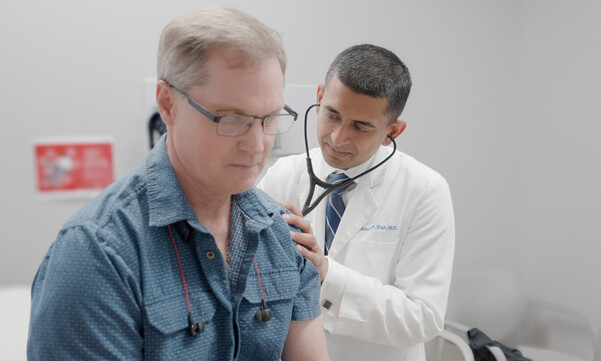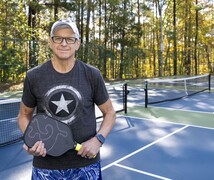On March 8, 2012, 33-year-old Stephen “Mac” McKiernan woke up and knew he didn’t feel right. As he was dressing, he noticed how swollen his feet were. “I could barely get my shoes on,” he says. “But I had to get to work.”
McKiernan, who lives in Connecticut, had a job in sales. At work that morning, he was preparing to deliver some materials when his boss told him he wasn’t going to be getting on the road that day, except to go to a hospital. McKiernan checked a mirror and saw his face was a frightening bright yellow. Still his mind was on his obligations – he and his fiancé, Angela, had plans for her birthday that weekend. “I’ll go to the doctor on Monday,” McKiernan offered. “His boss said, “you’ll go to the hospital right now or you’re fired.”
"I will be forever thankful that the long road I’ve stumbled down brought me to Duke.”
Liver and kidney failure
McKiernan was admitted into a Connecticut hospital and stayed for the next nine months. He was in liver and kidney failure, and he was so sick that his doctors couldn’t even perform the tests needed to determine what had landed him in this critical state.
“I came down with every infection under the sun during my first few months in the hospital,” he says. He and his fiancé had to cancel the wedding they had planned for September 2012; McKiernan began kidney dialysis and was placed on the list for a new liver and kidney. But in that part of the country the waiting list is long – he was told that it could take up to seven years. McKiernan didn’t consider that an option.
Out of the hospital, McKiernan continued to undergo the grueling five-hour dialysis three times a week, and he started researching different organ transplant programs. Angela’s mother lives in Cary, NC, and works for Duke University. Through research, McKiernan learned he could be eligible for Duke’s transplant list if he relocated to North Carolina. Just before Thanksgiving 2013, he moved in with his future mother-in-law. “It’s not exactly what one expects to be doing,” he says with a laugh, “But she made a good roommate.”
A liver and kidney were waiting
McKiernan became a patient of Carl Berg, MD, Duke’s medical director of abdominal transplantation. McKiernan was told it could be three months before he’s get his transplant. “I sat by the phone every night waiting for it to ring,” he says.
His fiancé wasn’t able to move to North Carolina because of work. But she and McKiernan’s parents did come down to spend the Christmas holiday in North Carolina.
On Christmas Eve, McKiernan was in dialysis when the call came: a liver and kidney were waiting for him at the hospital.” I had to wait two-and-a-half more hours to finish my dialysis,” he says. “All I wanted to do was run to the hospital.”
McKiernan received a kidney and liver transplant on Christmas Day 2013. And he wasn’t the only Duke patient to get that gift – surgeon Bradley Collins, MD, who performed Mac’s transplant along with surgeon Kadiyala Ravindra, MBBS, says that seven patients received new organs on Christmas Day last year.
Duke’s abdominal organ transplant program performs 60 to 65 liver transplants, 100 to 120 kidney transplants, and five to 10 pancreas transplants every year.
Instantly feeling better
“The second I woke up from the transplant, I felt like a completely different person, like I was in my twenties again. My head was clearer. It was like all of a sudden, math got a whole lot easier,” McKiernan says, laughing. Collins says that although there is physical pain during the healing process after a transplant, many patients do report feeling instantly better once they receive their new organs.
Instead of three months, McKiernan had waited only six weeks before receiving his transplant at Duke. After another six weeks, he had recovered so well that his doctors cleared him to go back to Connecticut.
“After the last couple of years I’ve spent a lot of time in a few different hospitals and physical therapy places,“ Mac says, “but I have to say that Duke was really amazing. I loved all the people, and everything went very smoothly. I will be forever thankful that the long road I’ve stumbled down brought me to Duke.”
Still in touch with Duke transplant team
A biopsy of his liver showed that McKiernan has sarcoidosis, a systemic disease that doesn’t commonly affect the liver but in his case, may have been leading him toward multiple organ failure over the course of several years. Back home in Connecticut, he’s now under the care of physicians at Yale, but he still keeps in touch with is Duke team. “It’s just a little extra comfort,” he says.
“McKiernan says he feels more than 100 percent better now. “My numbers come back stellar every time they get checked,” he says. “It was a lot to go through but a lot of people in my situation have waited a lot longer and have gone through a lot more.” In fact, he says one of the only real problems he had during his time in North Carolina was getting stuck for four hours on Interstate 40 during a snow squall. He also blames the Starbucks at Duke University Hospital for his newfound addiction to pastries.
McKiernan and his fiancé are now re-planning the wedding they had to cancel in 2012, and they hope to be married next summer. “Everything seems to work out,” he says. “But my mother in law is worried I’ll never come down to visit her again.”
Abdominal organ transplants at Duke
Duke’s abdominal organ transplant program performs 60 to 65 liver transplants, 100 to 120 kidney transplants, and five to 10 pancreas transplants every year. Fewer than 5 percent of liver recipients get a kidney at the same time; Duke’s first combined liver-kidney transplant was performed in 2000.





